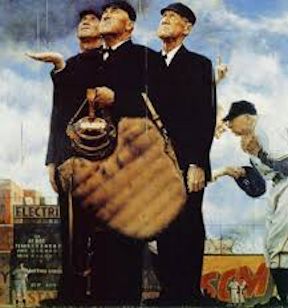 Illegal Pitches
Illegal Pitches
There are a large number of rules that apply only to the pitcher, and nearly all of them apply only when the pitcher is in contact with or astride the pitching plate (the "rubber"). When there are runners on base, these actions result in a balk. When there are no runners on base, most (but not all) of these actions result instead in an illegal pitch.
Pitching prohibitions
Illegal pitches and "pitching prohibitions" are covered in Rules 6.02(b) and 6.02(c)(1-9):
6.02(c)(1): First, the pitcher may not touch the ball after having touched his mouth or lips unless he first wipes his hand dry before touching the ball. This applies within the 18-foot circle surrounding the pitcher's plate (that is, while on the mound). Second, while in contact with the pitcher's plate, the pitcher must not even touch his mouth or lips.
- Exception: In cold weather, with agreement of both managers, you may allow pitchers to blow on their hands while on the mound.
- Penalty: Remove the ball from play and warn the pitcher. If the pitcher does it again, call an illegal pitch and award a ball to the batter.
6.02(c)(2): Pitcher may not spit ("expectorate") on the ball, either hand, or the glove. The umpire has some discretion in judging intent, so that he may issue a warning instead of ejection on the first violation.
6.02(c)(3): Pitcher may not rub the ball on his glove, clothing, or on himself. He may only rub the ball with his bare hands.The umpire has some discretion in judging intent, so that he may issue a warning instead of ejection on the first violation.
6.02(c)(4): Pitcher may not apply any foreign substance to the ball. This goes beyond the "expectorate" prohibition and applies to anything at all (including dirt).
6.02(c)(5): Pitcher may not deface the ball (cut, scratch, or in any way alter the natural state of the baseball).
6.02(c)(6): Pitcher may not deliver a ball that's been altered in any way. This covers the scenario where the catcher or other member of the team alters the ball. If a ball is badly scuffed due to normal wear and tear, the pitcher may request a new ball from the umpire.
6.02(c)(7): The pitcher may not have on his person any foreign substance. Just having posession on the field of an illegal substance is sufficient to draw a penalty. (Rulebook comment: "The pitcher may not attach anything to either hand, any finger or either wrist (e.g., Band-Aid, tape, Super Glue, bracelet, etc.). The umpire shall determine if such attachment is indeed a foreign substance for the purpose of Rule 6.02(c)(7), but in no case may the pitcher be allowed to pitch with such attachment to his hand, finger or wrist.")
6.02(c)(8): The pitcher may not intentionally delay the game by throwing the ball to players other than the catcher while the batter is in the box and ready to bat, except when this is a legitimate attempt to retire a runner on base. Warn the pitcher, and if it continues, you may eject the pitcher.
6.02(c)(9): The pitcher may not intentionally pitch at the batter. If you suspect the pitcher of intentionally throwing at a batter, you may warn the pitcher, or eject, if warranted. You may also, if appropriate, eject the team manager. You may also apply an "official warning" to both benches, such that subsequent instances will result in ejections of pitchers from either team.
Penalty for an illegal pitch
The pitch shall be called a ball. If a play follows the illegal pitch the manager of the offense may advise the plate umpire of a decision to decline the illegal pitch penalty and accept the play. Such election shall be made immediately at the end of the play. However, if the batter hits the ball and reaches first base safely, and if all base runners advance at least one base on the action resulting from the batted ball, the play proceeds without reference to the illegal pitch.
Important: Even if the team elects to take the play, you still recognize the infraction and appropriate penalties should be applied.
NOTE: A batter hit by a pitch shall be awarded first base without reference to the illegal pitch.

